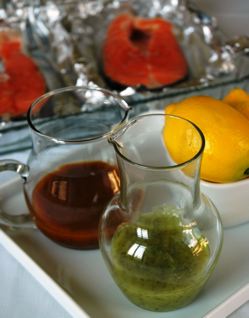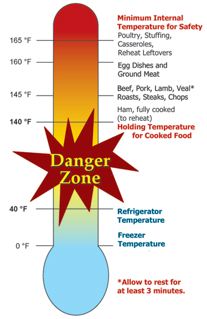
Summertime parties or picnics can be wonderful social events, but they can also pose some potential health risks when it comes to unwanted food safety and/or potential food allergy, sensitivity, or intolerance situations. You need to be food SMART when it comes to attending any Summertime party or picnic.
SMART stands for:
S = Savvy about food safety / foodborne illness risk and/or potential food allergen, intolerance, or sensitivity reaction risk;
M = Makes adequate plans to have alternative food choices available so that each member of the group attending the event will be able to have something they can safely and confidently eat;
A = Actively prepares for attending the event by also bringing temperature safe food selections for your family and friends and other guests to be able to enjoy;
R = Recipe details accompany any dish you bring to the event so that others with any food allergy, intolerance, or sensitivity concerns can determine if they can safely consume the item or not from an ingredient perspective;
T = Time & Temperature aware so that you only consume cold food items promptly while they are still very cold and hot food items promptly while they are still hot enough.
(Image of salmon filets about to be marinated courtesy of salsachica at rgbstock.com).
The key to having a positive party/picnic experience is to not risk either food borne illness or some type of allergic or other undesirable reaction to something risky being unwittingly served at the event. This blog post is a followup one to our previous Summertime Cooking & Entertaining: Beyond Food Safety blog posted last month, which has been revised with more hotlinks if you care to check out the updated version.
The more you know about the food items being served and the better you are prepared with alternatives, the more likely your group is to have a positive party/picnic experience.
Adults are best off calling many days ahead of the event to advise the party or picnic host/hostess of any food allergen concerns for themselves or family members, etc.
SMART adults will bring some alternate items with them (under proper temperature control such as in a cooler filled with blue ice packs and being sure to keep that cooler out of direct sunlight) so that they know their individual family members and friends can eat safely, rather than take a chance there won’t be things at the party/picnic that are safe for their family members and friends to have. If any family or group members are in a higher risk group when it comes to risk of foodborne illness or risk of exposure to a source of a food allergen, sensitivity or intolerance, then be extra careful for their sake. Those at higher risk status for foodborne illness would include anyone who is pregnant, very young children, anyone with a chronic disease, and the elderly.
–Don’t eat any mixed food dishes at the event unless you are positive they are free of any allergens or cross-contamination if any of your group members have any food allergies, intolerances, or sensitivities.
 Bacteria grow at exponential rates when any food item is in the “danger” temperature zone (between above 40°F and below 140°F), especially if there is high moisture content and higher protein content along with less acidity.
Bacteria grow at exponential rates when any food item is in the “danger” temperature zone (between above 40°F and below 140°F), especially if there is high moisture content and higher protein content along with less acidity.
–Don’t eat any cold foods that haven’t been kept at or below 40°F until just before you got to the buffet line and if the items aren’t being served over ice, then just keep on going by them in the buffet line.
Dishes containing protein-rich foods as well as those with higher moisture levels are at the greatest risk for being a breeding ground for the pathogens that cause food-borne illnesses. Some of the food items at highest risk for bacterial contamination include higher protein content items such as any “meat” (meaning in this instance beef, ham, pork, poultry, fish/seafood, etc.) or sausage, salami, or egg or dairy product based items, or cooked rice dishes, cooked pasta dishes, various cold salads including cole slaws, rice salads or pasta salads, and prepared fruit salads.
Danger Zone temperature graphic courtesy of USDA–go directly to the site via the hotlink to see a larger scale version of the graphic.
In hot weather, cold food items ideally should be stored in the refrigerator until service time. If guests brought such items to the event, you may not know if they kept the cold food items cold enough, so you just might want to pass on those items.
Talk to your host/hostess about any cold food items they have prepared (or bought pre-made) trying to find out enough details to know if the item will pass the food safety concerns you might have as well as any potential food allergy, intolerance, or sensitivity concerns you might have for yourself or a family group member such as a child.
–Don’t serve yourself or others any hot food items that haven’t just come off the heat source and are no longer at or above 140°F. There are advantages to safe food handling that involve proper use of chafing dishes, covered slow cookers, and warming trays.
If any BBQ “meat” food items weren’t cooked using a food thermometer, just go on by them in the buffet line. Pathogens that can cause foodborne illness are no joke!
If another guest brought a meat-based hot food item, be alert that most likely the item has been left out of the correct temperature zone for awhile and you might just want to skip the item, too. In general, it is better for the event host/hostess to prepare properly stored meat protein items directly on-site rather than have attendees bring such items in pre-prepared which can increase the risk of food-borne illness issues.
–Don’t eat any items off the BBQ grill if you notice whoever is manning the BBQ grill forgot about potential food safety cross-contamination issues and inadvertently used the same platter and same utensils for both raw and cooked “meat” (high protein content food items such as chicken, pork, beef, fish and mixed kebabs). You never want raw “meat” items or their juices to contaminate cooked “meat” or other items.
–Don’t eat any items off the BBQ grill if you notice any marinated high protein “meat” content items weren’t refrigerated until it is time to cook them off.
Also, you might want to skip the BBQ items if the host/hostess doesn’t either cook the “meat” farther away from the heat source to avoid flare ups, or else forgot to line part of the grill with aluminum foil dull side up to cook the “meat” items on to help reduce flame flareups or cook the items on say a food safe grade wooden plank to again keep food items away from flame flare ups. Many people today are concerned with potential carcinogens associated with BBQ preparation of “meat” category items and want to be more proactive about their health.
Remember that any marinades in which any raw “meat” item(s) were prepared in need to be cooked off (boiled) as well if they are to be used with the cooked “meat” items at service time.
–Don’t eat any items that are being “held” at room temperature waiting their turn to go to the buffet line without a way to keep cold items truly cold (at or below 40°F) and hot items truly hot (at or above 140°F).
In hot weather the service time needs to be kept short since bacteria multiply so very fast at warmer air temperatures on a hot summer day so no items should be “held” until later once they are either taken out of the refrigerator and put on ice or cooked off and placed in a chafing dish–they should be served and consumed immediately.
Although indoors in winter we allow a bit more total time for a food item to be out in ambient room temperature during preparation and proper service, outdoor temperature in summer can be much higher (as can indoor temperature as well) so the typical two (2) hour rule of being on a buffet line with adequate ice or adequate heat (& covered) as applicable is prudently cut down to no more than one (1) hour instead when ambient temperatures are at that 90°F mark so typical on hot summer days.
–Don’t eat any items where the same serving utensil is being used to serve multiple cold or multiple hot food items. If anyone in your household has concerns for food allergens, then watch out for additional potential cross-contact for allergens which is another arena of cross-contamination issues.
–Remember to get fresh plates & eating utensils if you do go back for further servings of any food items (checking to be certain your host/hostess is properly replenishing food choices using new platters or serving dishes with fresh serving utensils).
It can be challenging when children are involved at a party or picnic as they can see so many food items and may want them (not realizing they might potentially contain allergens, etc.), but if there is any doubt about how an item was procured, prepared, stored, or is being served (seriously–don’t allow a utensil to be used to serve more than one item) then it is better to insist the child (or adult) skip any potentially at-risk item(s) at the picnic or party.
Again, it is important to be sure to pack some safe food “alternative” choices with you that are stable at summertime temperatures so that you know there is something that everyone in your family group can eat at the event.
It really does matter to be prepared, since then you can relax being confident about the food items you brought and simply enjoy being in the company of others at the party or picnic.

